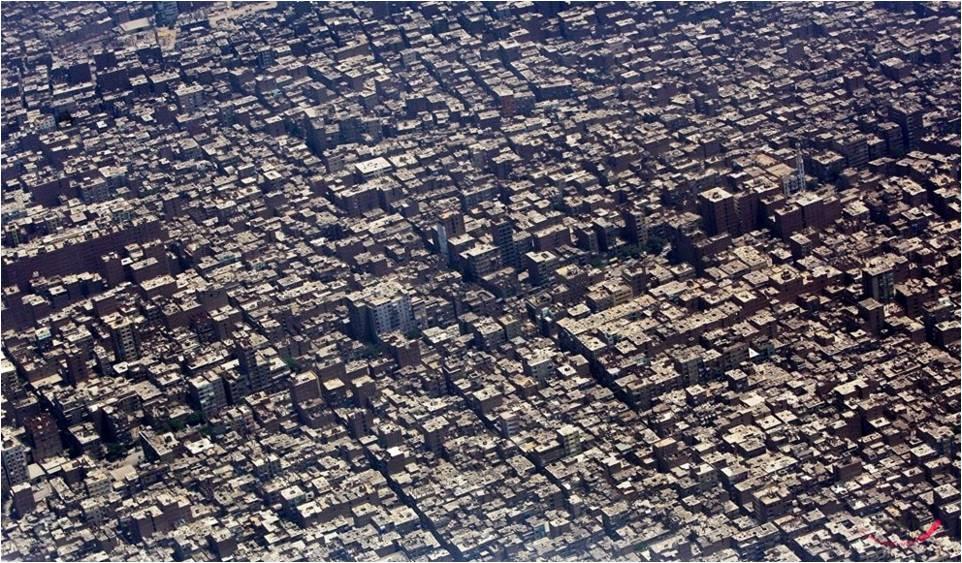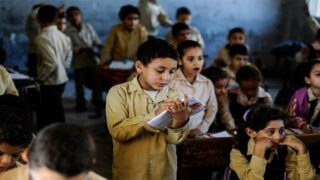
This publication has benefited from the support of the Rosa Luxemburg Foundation. This text may be reproduced in part or in full, provided the source is acknowledged.
In the village of Banawit in El Maragha Centre in Sohag Governorate in southern Egypt, Leil, the girl with tresses, stood with her girlfriends atop the primitive rural building she inhabits. In stifled weeping, she bid farewell to five caskets that villagers carried to the cemetery. Five people, one of whom is a schoolfriend of hers, fought the novel coronavirus, to be defeated one dark day. According to her account, the village, categorised among the most impoverished villages in Egypt, with a population of nearly 20 thousand people, has not had one house without one to three Covid-19 infections, or one death, during its latest and third wave.
Banawit wasn’t the only village in Sohag to become a Covid-19 epicentre. This past April, Egyptian social media buzzed with calls for help to the president of the republic, his government, and Sohag’s governor, asking them to quickly intervene. Doctors who worked in isolation centres during the third wave there estimated an average of 250 to 350 Covid-19 patients per day. Deaths and a glaring shortage of ICU beds and oxygen cannisters sapped hearts out and terrified people. This once, disaster wasn’t expected. And yet, despite the dark picture painted and transmitted from each and every village of the governorate, official statements issued by the most controversial minister in the history of the Ministry of Health would agitate people. The minister “confirmed the invalidity” of such news shared over social media, describing them as incorrect. She said so, that is, even though visual content broadcast from hospitals and homes indicated deteriorating pandemic conditions in the governorate, and was confirmed by calls for help that the leader of the Egyptian Medical Syndicate made in Sohag.
Upper Egypt (in southern Egypt) tops the list of the country’s poorest governorates. 59.6 percent of Sohag’s population is included in the Egyptian map of impoverishment, with 236, out of 270, impoverished villages (equalling 87 percent of the governorate’s villages). As such, Sohag’s villages topped the list of the 1000 most impoverished villages in Egypt. Naturally, housing in those small villages is categorised as dilapidated, and is generally subject to a style of shantytowns, which, even when established on private land rather than public property, still don’t meet proper housing conditions.
Policies and shantytowns
The novel coronavirus brought attention to incarnations of fragility that have unfolded from socioeconomic policies implemented since the 1970s. Those started with former President Anwar Sadat and are ongoing today. Perhaps most prominent are those policies linked with Egyptian public health. Some places on the Egyptian sociosanitary map receive no real official attention; they are home to rapid viral spreads and result in the majority of infections, according to estimates provided by doctors who work in Covid-19 quarantine hospitals. Those are unofficial housing areas (houses built without authorised planning, and some authorised, but old or rundown, houses) known as shantytowns. Deprived of any social or economic care, the impoverished inhabit those towns, and have been devastatingly infected with the virus; their lifestyle exposes them to many risks, and they fail to adhere to the recommended sanitary guidelines and physical distancing.
Upper Egypt (in southern Egypt) tops the list of the country’s poorest governorates. 59.6 percent of Sohag’s population is included in the Egyptian map of impoverishment, with 236, out of 270, impoverished villages (equalling 87 percent of the governorate’s villages). As such, Sohag’s villages topped the list of the 1000 most impoverished villages in Egypt.
Shantytowns in Egypt vary between peripheral housing, built for purposes other than habitation, like garages, shops, and staircases (according to a report issued by the Central Agency for Statistics in 2020, for instance, which determines housing unit types and room numbers, in Cairo alone, 2,887 families live in shops); “nest” housing, located by canals and railway junctions; archaeological compounds (which are home to 1,123 families in the capital alone); relief camps, which are primitive tents and houses that the state built for those who lost their houses for earthquakes; cemeteries, unique to Cairo (520 families); unlicensed and depreciated shantytowns in old and popular neighbourhoods; scavenger housing in Helwan suburbs and Mukattam Hills in Cairo (no official census of their numbers exists, but they could be categorised as living in a one-bedroom or two-bedroom units, which house 27,222 households, according to the official census); and, lastly, solitary one-bedroom housing on rooftops and backyards or in neighbourhood suburbs (nearly 93,210 households in the capital, with each household is considered an average of 4 family members).
Furthermore, half the population of the Greater Cairo Area (a name given to an administrative entity that comprises the Cairo, Giza, and Qalyubiyya Governorates) which, according to most recent data published by the National Population Council in 2020, is home to nearly 20 million and 901 thousand people, live in shantytowns.
According to the 2017 Egyptian census, nearly one and a half million households across Egypt live in a one-bedroom unit, at a rate estimated at 6.4 percent of the overall number of Egyptian households, whose number, at the time of the census, had reached 23.5 million. Furthermore, 2.6 percent of Egyptian households live in one or more bedrooms in one housing unit. [1]
The novel coronavirus brought attention to incarnations of fragility that have unfolded from socioeconomic policies implemented since the 1970s. Those started with former President Anwar Sadat and are ongoing today. Perhaps most prominent are those policies linked with Egyptian public health.
Shantytowns (which, both official and unofficial, occupy 39 percent of the overall area of urban clusters, rendering them at 7 percent of the overall area of the country) lack proper housing standards, like clean water and sanitation networks, safe modes of transportation, and adequate healthcare. [2] All of the above has resulted in constant population exposure to disease and epidemics in pre-Covid-19 years, which has thus made them even more susceptible to a Covid-19 infection, triggering its transmission into other areas, where they carry out their daily affairs beyond their residential spaces.
Clean water and sanitation
It comes as no surprise that the Industrial City of Helwan, south of Cairo, and home to the second largest shantytown in the Greater Cairo Area [3], was categorised in November 2020 as the most affected city by the virus. Official data that detailed, for the first – and last! – time the number of Covid-19 infections in the capital in one month demonstrated that the virus had reached them with 1,932 infections, followed by areas east of Nasr City at 1,872 cases, El Matareya at 1,662 cases, El Marg at 1,416 cases, and El Basateen at 1,331 cases, all of which comprise squatter settlements.
As a model of shantytowns affected by the Covid-19 pandemic from within the southern city, infections of the novel coronavirus spread in Al Mawassla area, into its second wave during November 2020, where not one house was spared contamination, with at least one infection, or more – according to residents’ testimonies. There are no official detailed statistics of the number of infections in that area, but the doctors of the only general hospital that services the city (the hospital serves a vast area of El Saff and Atfih in El Giza Governorate, and even Tura Town, with more than 3 million people) confirmed it through in-person interviews.
In November 2020, the Industrial City of Helwan, south of Cairo, and home to the second largest shantytown in the Greater Cairo Area, was categorised as the city most affected by the virus. Not one house was spared contamination, with at least one infection, or more – according to residents’ testimonies.
Al Mawassla is considered a shantytown established by the cemeteries, with the biggest cluster of clay, tin, and wooden roofs built in the 1960s. Theirs is an environment fit for insects, rodents, encouraged by waste pileup and garbage. Residents are used to recurrent water interruptions and sometimes resort to the nearby train station as a source of water. With such severe water scarcity, they therefore cannot wash their hands often throughout the day. Likewise, more than one household uses shared bathrooms (the 2017 official statistics observed that 386 out of 133,342 households in Helwan neighbourhood still go to the toilet outdoors, and have no access to either public or private bathrooms, whereas 7 households use a shared bathroom). This exposes them to viral transmission through their hands and dirty clothing, or through using toilets and faucets themselves that haven’t been disinfected.
Even though access to adequate and affordable potable water as well as access to a private or public bathroom shared by a reasonable number of individuals are some of the most important standards of habitability published by the United Nations Human Settlement Programme [4], the majority of shantytown residents in Egypt cannot access clean water. While official reports published by the end of 2020 reported that the percentage of access to drinking water throughout Egypt had reached 98 percent (100 percent in urbanised areas and 97.4 percent in rural areas), other official reports published in late 2020, like the Holding Company for Water, showed that contamination levels in water pumped into houses has reached 35 percent. It noted many detergents, chloride, and alum sulphate, which is an implicit acknowledgement by official bodies that the water that reaches homes is not entirely clean.
In the meantime, those same official reports stated that, throughout Egypt, sanitation networks covered 65 percent in 2020, 94 percent of which were city dwellers, and 34 percent of which were rural residents. From officially published data, one may deduce that 6 percent of city dwellers were still dependent on underground reservoirs, considered unofficial sanitation networks (made of uninsulated rocks, which results in wastewater leaking into the soil and mixing with drinking water). In parallel, 66 percent of both northern and southern rural Egypt residents still depend on that system and haven’t been incorporated into public sanitation systems yet.
Public health and its effect on the spread of Covid-19
In slum communities, especially those that have taken a permanent form of settlement, overpopulation abounds. As officials neglect public hygiene in those areas, considering them to be unofficial housing areas, viral transmission rates increased at a highly rapid pace, as did the number of patients with chronic terminal illnesses (no official statistics of health conditions in shantytowns are available).
Lack of access to clean water or a sanitation system, combined with cheap and harmful nutrition, is closely related to gastric, digestive, and kidney diseases. Reports and studies confirm that people infected with chronic digestive tract diseases (some of which are the result of drinking water contamination, the result of fusing with wastewater, as is the case of shantytowns, and food contamination) are especially more vulnerable to the virus. Those include patients with inflammatory bowel diseases, which peak between July and November in Egypt, digestive cancers (like colon, rectal, stomach, pancreas, oesophagus, and liver cancer), liver and kidney diseases (like in Kafr Sheikh Governorate in northern Egypt, where kidney failure rates are elevated in all its centres), anaemia induced by nutrition deficiency, respiratory diseases, like pneumonia, the common cold, and tuberculosis – caused by lack of adequate ventilation. Weakened immune systems, and the respiratory symptoms related to Covid-19, from which shantytown residents already suffer, renders the residents of those areas more vulnerable to the coronavirus (as is the case in Helwan Industrial City). According to the Minister of Health, 85 percent of the people who ended up with infections or deaths already suffered pre-existing chronic diseases.
Here, it must be noted that infrastructure and healthcare services in shantytowns are extremely penurious. Healthcare services in the majority of Egyptian regions are centralised in all types of hospitals (public, central, and university hospitals). The capital is home to most such hospitals, which, according to official data published in April 2021, reached 134 hospitals, at a ratio of 74.2232 thousand citizens per hospital!
In slum communities, especially those that have taken a permanent form of settlement, overpopulation abounds. As officials neglect public hygiene in those areas, considering them to be unofficial housing areas, viral transmission rates increased at a highly rapid pace, as did the number of patients with chronic terminal illnesses… No official statistics of health conditions in shantytowns are available.
In shanty and impoverished towns, hospitals and equipped medical centres are quite scarce (there are less than 700 public hospitals [5] to service the entirety of Egypt). Likewise, hospitals, short of medical supplies, most crucial of which are oxygen cannisters and ICU beds, fight to manage the increased influx of Covid-19 patients. Medical doctors and assistance are also extremely limited. According to the records of the Egyptian Medical Syndicate, the overall number of registered doctors in both public and private sectors is 212,835 doctors, while more than 120,000 of them work abroad. That is, around 60 percent of registered doctors have migrated abroad as a result of the deteriorated economic situation and insufficient medical equipment.
A joint 2019 study prepared by the Supreme Council of Universities and the Ministry of Health noted that the medical workforce in Egypt made up 38 percent of overall registered doctors, and that 62 percent of Egyptian doctors worked abroad. The Egyptian Ministry of Health suffers a shortage of doctors in their public hospitals, who are down to nearly 50 thousand doctors.
Notably, there is a severe shortage of medical personnel in, naturally, shanty and impoverished areas where individuals can but pick a number in a long waiting list just to undergo a general medical checkup in a public hospital, or to be received at a local clinic with poor services and medical equipment. Because of the severity of the situation and the extreme overcrowding in hospitals that receive shantytown residents, many of the latter preferred not to go see a doctor when they sensed Covid-19 symptoms, and rather opted for a home-based isolation, if it were possible. They chose to do so for reasons related to elevated medical fees, compared to their monthly income, or for lack of available spots in hospitals.
With the third wave of the pandemic, official data continued to reveal no more than 1000 contaminations or 60 deaths a day – as only official cases are allowed to be screened for Covid-19 (Dr Mona Mina – former head of the Egyptian Medical Syndicate – noted that the testing rates in Egypt are considered low, as, according to WorldoMeter Egypt website, they didn’t exceed 9,686 per every one million citizens in early 2021). Furthermore, the study run by the Egyptian Centre for Public Opinion Research –Baseera [6]– explained that nearly 684,000 Egyptians 18 years of age or older had caught the virus during the second wave in November and December 2020. According to their report, the overall number of infections since the beginning of the pandemic and until the end of 2020 has reached 2.9 million. This corresponds with the statement issued by the Health Emergency Director of the Regional Office of the World Health Organisation in December of that same year, who noted that the number of Covid-19 infections registered by the Egyptian Ministry of Health doesn’t reflect the real number of infections on the ground. Furthermore, such underreported numbers affect citizens’ approach to the crisis, leading them to believe that things are back to normal. [7]
Transportation
Public expenditure on movement and transportation are considered a main item on the budget allocated to shantytowns, with many residents working beyond their living areas. There is a host of collective transportation, namely microbuses and tuk-tuks (domestic transportation vehicles) and, finally, the Cairo Tunnel Metro (used by nearly 3.5 million citizens a day within the Greater Cairo Area), all of which are considered the cheapest means available, despite their relatively high pricing for impoverished households. Due to overcrowding in such spaces, preventive measures are impossible to apply, which renders them most prone to Covid-19 transmission.
A study conducted by the Central Agency for Statistics on the fiscal year of 2019/2020 and published in March 2021 revealed that 74 percent of Egyptian incomes experienced a decline as a result of Covid-19 response measures and, therefore, 50.3 percent of households resorted to borrowing money from others.
According to a study conducted by the Central Agency for Statistics in March 2021 – which aimed at observing the effect Covid-19 had on Egyptian households during the first part of October and until December 2020 – household expenditure on transport and transportation declined by 6.1 percent in 2020, as opposed to 18.8 percent in 2019.
Sick but impoverished
In its report of 2019/2020, the Central Agency for Statistics determined the national Poverty Line per capita per year (cost needed to acquire basic goods and services per person) at 10.2 thousand Egyptian pounds a year, or an estimated average of 857 Egyptian pounds per month. The value ascribed to Poverty Lines vary between different areas. [8] The study, published by the Central Agency for Statistics in March 2021, revealed that 74 percent of Egyptian incomes experienced a decline as a result of Covid-19 response measures. 50.3 percent of households resorted to borrowing money from others (the Central Agency for Statistics reported that, according to residents’ estimates on January 1st 2021, the number of Egyptian households had reached 25.1 million), 17 percent of households relied on aid, 5.4 percent of households relied on irregular employment set up by the government, while 1.5 percent of households turned to selling a portion of their private property – and those are their more well off. Such conditions limit the purchasing power per capita in impoverished and shanty towns, rendering hygienic products, disinfectants, and surgical masks, all necessary as a preventive measure against Covid-19, unaffordable.
In April 2021, the Division of Machinery Traders, Supplies, and Medical Devices in the Cairo Chamber of Commerce reported a decline in demand for surgical masks during the third wave of Covid-19, at a rate that exceeded 50 percent. It also reported that Egyptians wore no masks unless they were in overcrowded areas, while shantytown residents preferred to buy surgical masks from street vendors, with unknown manufacturing data, to doing so from pharmacies. Elevated mask prices, ranging between 5 to 150 Egyptian pounds, depending on the type of mask, rendered them unaffordable. According to the Poverty Line determined by the Egyptian government, an individual’s income of no more than 857 Egyptian pounds would not suffice to buy a mask on a daily basis – a sole individual could incur 150 Egyptian pounds in monthly expenses (around 17 percent of their overall income) just to buy surgical masks – that is, without counting the rest of hygienic materials and disinfectants.
The unexpected surprise was the announcement of the Central Agency for Statistics, reporting a decline in poverty rates to nearly 29 percent during the past year (2019-2020) – as opposed to 32 percent in the preceding year. This contradicts previously published official data: at a time when political leadership bragged about a decline in poverty rates among Egyptians in the shadow of the Covid-19 crisis, a study by the Institute for National Planning [9] expected that the pandemic would result in a drop of income in Egypt and an increase in the number of impoverished people. The study presented a few scenarios, worst of which predicted poverty rates would go up to include 5.6 to 15 million individuals during the upcoming fiscal year, which starts in August 2021.
Autism in the Time of Corona
28-06-2021
As the pandemic continues, so continues public spending on the Egyptian health sector to dwindle. The official justification given is that Egypt has no ample fiscal space that allows it to spend any further resources on the sector. There seem to be no financial hurdles, however, when it comes to massive projects, whose governmental allocated budget surpasses healthcare’s by large. As the government announced, as per the head of the contracted company, that the new administrative investments and constructions ranged between 700 and 800 billion Egyptian pounds, the Shantytown Development Fund stated that their shantytown development budget was allocated no more than a mere 17 billion pounds.
As the pandemic continues, so continues public spending on the Egyptian health sector to dwindle. The official justification given is that Egypt has no ample fiscal space that allows it to spend any further resources on the sector. The government announced, however, that the new administrative investments and constructions in the capital ranged between 700 and 800 billion Egyptian pounds, while the shantytown development budget was to be allocated no more than a mere 17 billion pounds.
Perhaps the coronavirus crisis has revealed, loud and clear, that shantytowns have become a ticking bomb inside Egypt, and a major epicentre for the pandemic. Authorities are therefore required to reconsider their policies towards the residents of those areas, as well as restructure the crumbling healthcare system to serve the greater majority of Egyptians.
The content of this publication is the sole responsibility of Assafir Al-Arabi and Rosa Luxemburg Foundation cannot accept any liability for it.
Translated from Arabic by Yasmine Haj
Published in Assafir Al-Arabi on 02/07/2021
[1] Data from 2017, published in Egypt’s statistical indicator, 2020.
[2] “The Shadow Ministry of Housing: housing and urban rights”: http://blog.shadowministryofhousing.org/p/blog-page_1.html
[3] https://www.hindawi.org/books/68184917/2/
[4] https://unhabitat.org/topic/housing
[5] For further reading on healthcare in Egypt and lack of services, see: https://bit.ly/3xeWTss
[6] http://www.baseera.com.eg/RecentPolls2.aspx?ID=182
[7] “The Pandemic and the Healthcare Sector in Egypt: Light silhouetting the dark”, by Mona Sleem, Assafir Al-Arabi: https://assafirarabi.com/en/38389/2021/06/07/the-pandemic-and-healthcare-sector-in-egypt-light-silhouetting-the-dark/
[8] In a research on income and production in Egypt’s regions for the year 2019/2020, the highest Poverty Lines were found in urban governorates. The Poverty Line there was determined at 11,285 Egyptian pounds a year, and abject poverty at 7,071 Egyptian pounds a year. Poverty Lines were at their lowest in Lower Egypt urban areas, set at 9,755 Egyptian pounds for the overall Poverty Line and 6,304 for abject poverty.
[9] Link to see overall studies conducted by the Institute for National Planning: https://bit.ly/3wa3gvJ






